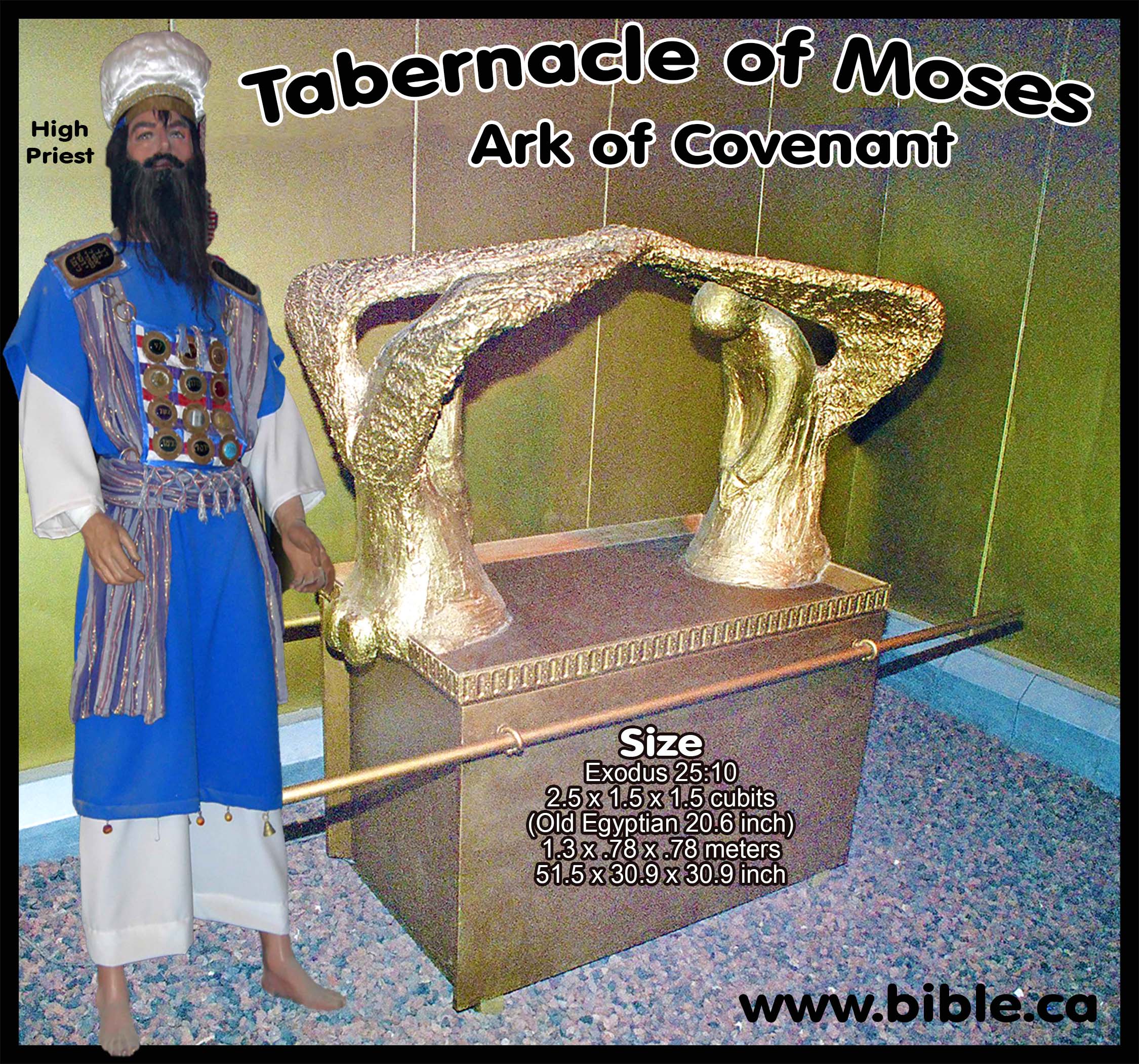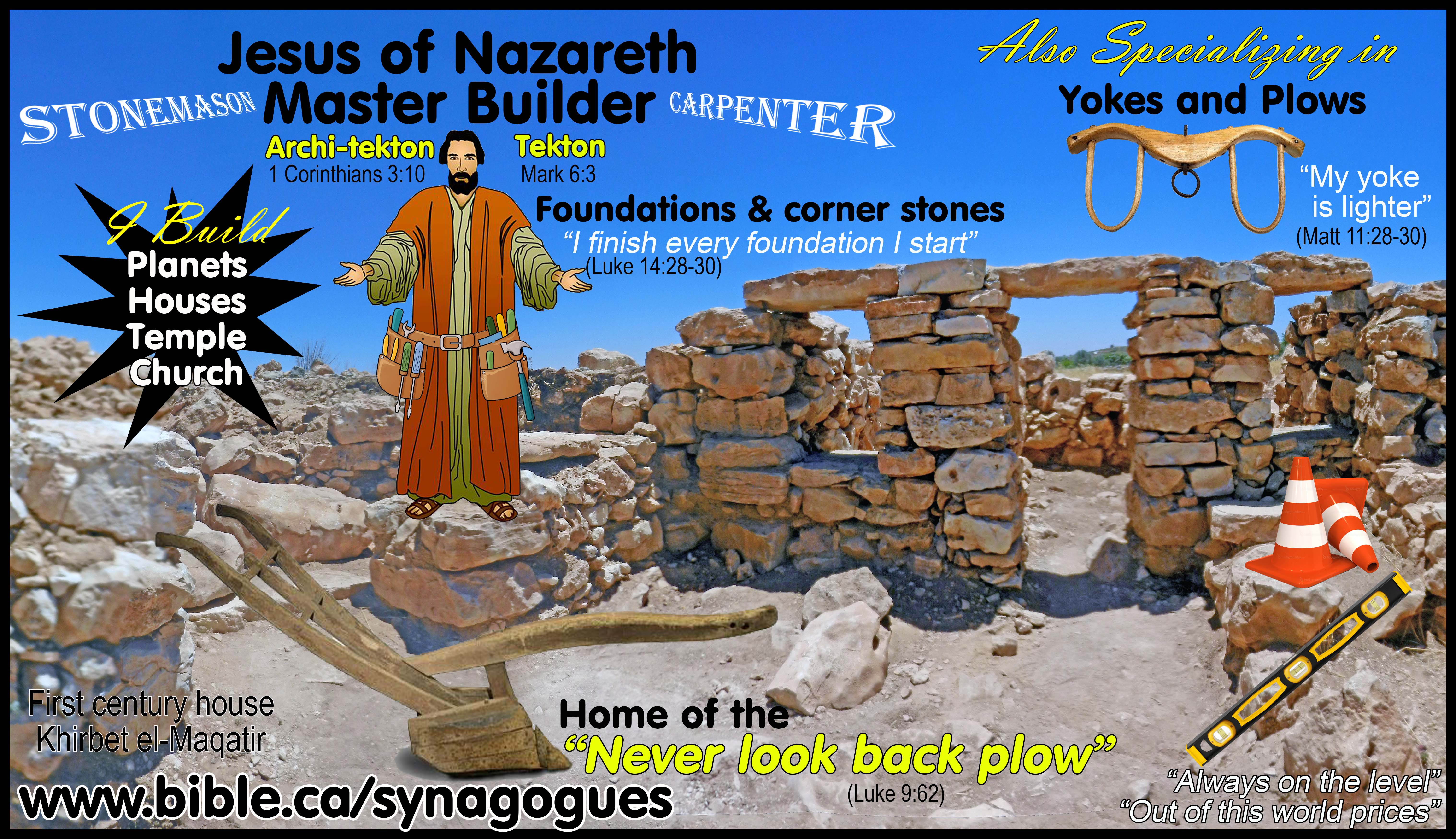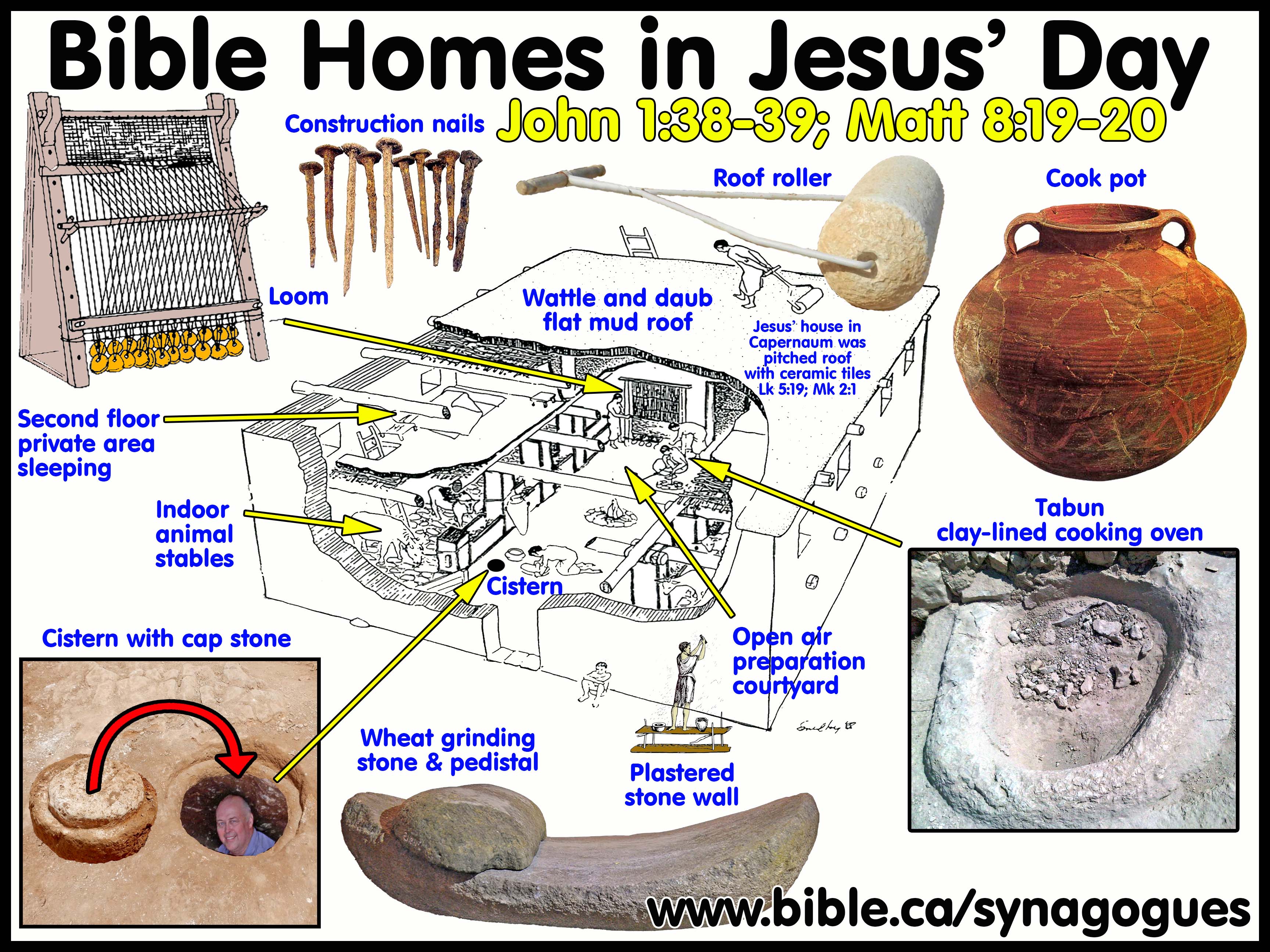Standardized Architectural Synagogue Signature Typology
Synagogue Architecture adopted by the Christian Church
Floorplans and Furnishings of Pre-70 AD Second Temple Period synagogues
Inside the Ark of the covenant was a copy of the Ten Commandments.
On the side of the Ark of the covenant was a copy of the Torah, or Book of the Law.
“Take this book of the law and place it beside
the ark of the covenant of the LORD your God" (Deut 31:24–26)
1. The Ark of the Scrolls cart pictured above from Capernaum comes from an architectural stone mantle from the ancient synagogue.
a. While the Philistines and David wrongly transported the Ark of the Covenant on a cart with wheels, there was nothing wrong with using such a cart in early Synagogues.
b. This rare engraving in limestone shows that the cart was movable and could be taken through the streets, just as the Ark of the Covenant was on about 5 occasions in Old Testament history.
c. The fact these early Torah Shrines were wooden is why we don’t find them in archeological digs.
2.
The forerunner of the Torah Shrine was the Tabernacle Ark of the
Covenant: Deut 31:24–26

a. "It came about, when Moses finished writing the words of this law in a book until they were complete, that Moses commanded the Levites who carried the ark of the covenant of the Lord, saying, “Take this book of the law and place it beside the ark of the covenant of the Lord your God, that it may remain there as a witness against you." (Deuteronomy 31:24–26)
b. Inside the Ark of the covenant was a copy of the Ten Commandments.
c. On the side of the Ark of the covenant was a copy of the Torah, or “Book of the Law”
d. From 1096 - 967 BC the ark of the covenant was separated physically from the Tabernacle tent only to be reunited with the Holy of Holies in Solomon’s Temple.
e. The ark of the covenant disappears off the map of history at the Babylonian destruction of the temple of Solomon in 587 BC.
f. Messianic prophecy that there was no need for the ark because its function as a mercy seat was fulfilled in the blood of Christ: “Then I will give you shepherds after My own heart, who will feed you on knowledge and understanding. “It shall be in those days when you are multiplied and increased in the land,” declares the Lord, “they will no longer say, ‘The ark of the covenant of the Lord.’ And it will not come to mind, nor will they remember it, nor will they miss it, nor will it be made again. “At that time they will call Jerusalem ‘The Throne of the Lord,’ and all the nations will be gathered to it, to Jerusalem, for the name of the Lord; nor will they walk anymore after the stubbornness of their evil heart." (Jeremiah 3:15–17)
3. Synagogue storage of Holy Scripture: The Niche and the Ark cabinet:
a.
Ark of the Scrolls, Torah Shrine, Holy Ark of the scripture scrolls,
aedicule is a simple storage cabinet made from wood or stone.

b.
“THE ARK OF THE SCROLLS: The Ark of the Scrolls, located inside the Torah
Shrine, was a chest or ark, commonly of wood, that contained shelves to hold
the Torah scrolls. In the Land of Israel. this Ark is usually depicted as a
chest with closed double doors surmounted by a gable decorated with a conch.
However, in the Diaspora, theArk is shown as an open chest containing scrolls
placed on shelves (Hachlili 1988:272278; 1998:366-370; 2000:157-159). The
location of the Ark arid its form can be deduced from remains found in
synagogues of the Land of Israel, its depiction on mosaic pavements such as
Hammath Tiberias B, Sepphoris, and Susiya (Figs.. IV-53, VI-1, 2), and various
other objects, and from inscriptions which mention it. Synagogue excavations
and historical research have greatly augmented the evidence, and now it may
reasonably be inferred that such arks stood inside the architectural structure
of the Torah shrine. ” (Ancient
Synagogues - Archaeology and Art: New Discoveries and Current Research, Rachel
Hachlili, p199, 2013 AD)

4.
A niche or raised bema platform was often built into the architecture of
a synagogue to house a wooden Ark of the scrolls cabinet.

a. “Genizah: In several synagogues, an unusual feature has been observed in the Torah Shrine area. Spaces or depressions (cavities) behind the Torah Shrine have been found in the bases of aediculae, niches, or apses, evidently indicating the presence of a geniza. This space served as a community chest for fragments of scrolls, or as a cabinet for storage of various objects. In the Galilean synagogue of Gush Halav I, a rectangular depression (0.50 m x 0.75 m) was found in the early base, close to the southern wall (Meyers et al. 1979:42); a similar one was found at Nabratein (Meyers et al. 1981a:242). At Qasrin, the southern rear part of the Torah Shrine may have served as a geniza.” (Ancient Synagogues - Archaeology and Art: New Discoveries and Current Research, Rachel Hachlili, p192, 2013 AD)
b.
“The Torah Shrine [Ark of the
Scrolls], in most of the Galilean synagogues is formed
by one or two platforms [bema] (usually an aedicula) added to the
interior of the southern Jerusalem-oriented wall between the façade entrances:
at Capernaum, Korazim, Meroth, and Nabratein there are two aediculae; Gush
Halav, Hamam, Kfar Misr 1, Meiron, Sepphoris, and H. Shem`a each have one. At
Kfar Misr a niche was built in Phase 2 and an apse in Phase 3, while at Arbel 2
an apse was built. Stone benches were built along two or three walls, after
placement of the pavement, at Arbel, Capernaum, Hamam, Kfar Misr, Korazim, and
Meroth. ” (Ancient Synagogues - Archaeology and Art: New
Discoveries and Current Research, Rachel Hachlili, p155, 2013 AD)

c. “The Torah Shrine Structure: In most synagogue excavations in the Land of Israel and in the Diaspora, an important fact has emerged: that nearly every excavated synagogue yields fragments, traces, or the actual site of the Torah Shrine, even those dated as early as the end of the second century CE. The Torah shrine structure in ancient synagogues, both in the Land of Israel and the Diaspora, took one of three forms: aedicula, niche, or apse (Hachlili 1988:166-187; 2000:147-157).The expression 'Torah Shrine' denotes the architectural stone structure on the Jerusalem-oriented wall which housed the Ark of the Scrolls. Each of these categories had its own structural form, but all served as repositories for the Ark of the Scrolls: a raised platform as a base for the aedicula, made of stone or wood on which the wooden Ark of the Scrolls was placed; it should be noted that some excavators relate to this platform as a bema; a niche built into the interior wall, probably to hold a wooden Ark of the Scrolls; an apse built on the interior wall to hold the Ark of the Scrolls and sometimes the menoroth. All three categories served as repositories for the Ark, though each had its own structural form. Some exceptions—synagogues without any traces of a permanent place for the Torah Shrine in the building architecture—do exist, but most of these are either unexcavated or destroyed to such an extent that it is impossible to locate the site of the Torah Shrine. a bema. In some synagogues, a bema—a raised stone platform—is built in front of a niche or apse. This structure does not house the Ark, and was probably employed in other functions, for instance, as a table for the reading of the Torah (see below); the Ark of the Scrolls was the actual ark or chest (usually wooden) which contained the Torah scrolls and stood in a repository—either aedicula, niche, or apse. ” (Ancient Synagogues - Archaeology and Art: New Discoveries and Current Research, Rachel Hachlili, p163, 2013 AD)
a. “The aedicula included a base—a platform of stones (sometimes incorrectly called a bema), and has been reconstructed from remains found in synagogues. Over this stone base stood the actual aedicula structure, which usually consisted of a stone façade with two to four small columns surmounted by a decorated lintel (Fig. IV-26). ” (Ancient Synagogues - Archaeology and Art: New Discoveries and Current Research, Rachel Hachlili, p168, 2013 AD)
5. The location of the Ark of the Scrolls varied:
a. The was often placed on the wall opposite the door.
6. The Ark of the Scroll would sometime have curtains and the scrolls themselves would have coverings of metal, wood or cloth:
a. “A curtain which is on an ark has the status of the ark” (Jerusalem Talmud, y. Meg. 3:1, II.7.B)
b. “He who makes an ark for a scroll and covering for a [hob] scroll” (Jerusalem Talmud, y. Meg. 3:1, II.4.C)
c. “Townsfolk who sold a street of a town may buy with its proceeds a synagogue. [If they sold] a synagogue, they may buy an ark. [If they sold] an ark, they may buy wrappings. [If they sold] wrappings, they may buy scrolls [of the prophets or writings]. [If they sold] scrolls, they may buy a Torah scroll. But if they sold a Torah scroll, they should not buy scrolls. [If they sold] scrolls, they should not buy wrappings. [If they sold] wrappings, they should not buy an ark. If they sold] an ark, they should not buy a synagogue. If they sold] a synagogue, they should not buy a street. And so with the surplus [of the proceeds of any of] these.” (Jerusalem Talmud, y. Meg. 3:1)
d. “As to these [namely, the ark for a scroll or coverings for a scroll]―if one had made them to begin with for secular purposes, and then went and consecrated them, what is the law governing them?” (Jerusalem Talmud, y. Meg. 3:1, II.4.K)
7. The ark of the scrolls was considered holy and sacred:
a. “Our rabbis have taught on Tannaite authority: For three sins women die in childbirth. R. Eleazar says, “Women die young.” R. Aha says, “For the sin of covering up their babies’ shitty diapers on the Sabbath.” Others say, “Because they call the holy ark ‘chest.’ ” It has been taught on Tannaite authority: R. Ishmael says, “For two sins ignorant people die, because they call the holy ark ‘chest,’ and because they call a synagogue ‘a house of the people.’ ” (Babylonian Talmud, b. Shabb. 2:6, I.8.A–9.B)
8. “They bring forth the ark into the street of the town and put wood ashes on the ark, on the head of the patriarch, and on the head of the head of the court.” (Mishnah, m. Ta'an. 2:1 B)
9. Minors were prohibited from touching the Ark of the scrolls or public reading.
a. “He who concludes with the prophetic lection is the one who recites the Shema [with its blessings fore and aft], and passes before the ark, and raises his hands [in the priestly benediction]. But if he was a minor, his father or his teacher pass [before the ark] in his behalf. It was necessary to include the Mishnah’s rule only to indicate that the one who recites the Shema is the one who passes before the ark, and he is the one who raises his hands [since these are all part of the liturgy]. R. Yosé b. Haninah said, “It was so as to give encouragement [to the one who did all these things, assigning them all as a form of recognition to him].” But if he was a minor, his father or his teacher pass before the ark in his behalf. And lo, we have learned: A minor does not recite the Shema [M. 4:7B]. Said R. Yudan, “In this case [in which he may do so] it is when he has produced two pubic hairs, and in that case, in which he may not do so, he has not yet produced two pubic hairs.” (Jerusalem Talmud, y. Meg. 4:6)
10. The liturgy (order of worship) recorded in the Jerusalem Talmud reminds us of Jesus standing up, being handed the Greek scroll of Isaiah, reading it and handing it back to the attendant: Luke 4:16-20
a. Jesus may have been seated in a random place, in a designated reader’s seat or even the Moses’ seat at Nazareth:
a. "And He came to Nazareth, where He had been brought up; and as was His custom, He entered the synagogue on the Sabbath, and stood up to read. And the book of the prophet Isaiah [Septuagint] was handed to Him. And He opened the book and found the place where it was written, “The Spirit of the Lord is upon Me, Because He anointed Me to preach the gospel to the poor. He has sent Me to proclaim release to the captives, And recovery of sight to the blind, To set free those who are oppressed, To proclaim the favorable year of the Lord.” And He closed the book, gave it back to the attendant and sat down; and the eyes of all in the synagogue were fixed on Him. And He began to say to them, “Today this Scripture has been fulfilled in your hearing.”" (Luke 4:16–21)
11.
Jewish Artistic depictions of the Torah Shrine:

a. “The Ark of the Scrolls in Jewish Art: In the Land of Israel, the Ark of the Scrolls is depicted either separately or inside the Torah Shrine façade, usually as a chest with its doors closed; sometimes there is also a symbolic conch, representing the absent Torah Shrine within which the Ark stood (Hachlili 1980:59-60; 1988:272-278, 280-285; 2000:158-159). The form of the Arkis portrayed in three general types: free-standing chest with a closed double ornamented door, based on two to four legs, surmounted by a gable or arched top that is sometimes decorated with a conch; such arks are portrayed on the mosaic floors at Beth Alpha, Na'aran, and Jericho (Figs. IV-53, 54); the highly stylized Jericho depiction has an arched top decorated with a conch. ” (Ancient Synagogues - Archaeology and Art: New Discoveries and Current Research, Rachel Hachlili, p200, 2013 AD)
b.
“In the Diaspora, the Ark of the
Scrolls is carved or painted as a free-standing, open chest, roofed by a gabled
or round top, without legs; the open doors of the Ark reveal shelves, on each
of which two or three circular, oval, or square scrolls are set. These arks
appear painted on catacomb walls and carved on tombstones; they have also been
found on gold glasses in the Jewish catacombs in Rome, on lamps found in Ostia,
and on a Sardis stone slab (Hachlili 1998:366-370, Figs. VII-46-48; 2000:159,
Figs. 15-17). The general
similarity in the depiction of arks in Diaspora catacomb art, with only slight
variations, supports the existence of a single Diaspora prototype, consisting
of an open-doored ark with scrolls lying on shelves. The design of an ark with
arched roof, open doors, and scrolls is treated more elaborately on gold
glasses than on catacomb tombstones, which are usually simple, incised renditions.
The ark on the gold glasses was very likely a more detailed version of the
catacomb image, which included scrolls, lions, and birds. It is quite possible
that both Jewish and pagan art shared a similar prototype for depicting scroll
chests and arks. The Diaspora Ark is usually depicted alone, with no indication
of an enclosure within which it stood. In the Land of Israel, however, the Ark
of the Scrolls and the Torah shrine are more often shown together. The
interesting differentiation—between the portrayal of the Ark of the Scrolls
with closed doors in the Land of Israel and the Diaspora examples with open
doors revealing scrolls lying on shelves—presents several questions.” (Ancient Synagogues - Archaeology and Art: New
Discoveries and Current Research, Rachel Hachlili, p204, 2013 AD)

12. Archeological examples of Niches and Torah Shrines:
a.
“At Nabratein 1 (dated to ca.135—ca.250)
the earliest aediculae used as a Torah Shrine were found: two stone platforms
flanking the main entrance, attached to the interior of the southern
Jerusalem-oriented wall; the western one was slightly larger. ” (Ancient
Synagogues - Archaeology and Art: New Discoveries and Current Research, Rachel
Hachlili, p170, 2013 AD)

b. “At Capernaum the white limestone synagogue contains bases of two aediculae—Platforms' M and N—discovered flanking the inner side of the main entrance and attached to the interior of the southern Jerusalem-oriented wall (Fig. IV-30). They are constructed of a layer of strong lime mortar, laid over gravel which rests upon a 0.25 cm. thickness of basalt flagstones (Corbo 1975:118-121, Fig. 18, photos 52, 55; Strange 1977:70). It is possible that some fragments at Capernaum (such as those illustrated by Kohl and Watzinger 1916:Figs. 21, 22, 70, 71) may have been parts of such aediculae.” ” (Ancient Synagogues - Archaeology and Art: New Discoveries and Current Research, Rachel Hachlili, p171, 2013 AD)
c. “At Korazim, two aediculae were discovered abutting the inner Jerusalem-oriented south facade and flanking the main entrance; several stones of the base on the west were recovered (Fig. IV-31): one aedicula is considered a Torah Shrine, the other a platform (bema, iztaba) in which stood the `Seat of Moses'. ” (Ancient Synagogues - Archaeology and Art: New Discoveries and Current Research, Rachel Hachlili, p171, 2013 AD)
d.
The great Shrine of the
Scrolls at Ostia:


13. The Ark of the Scrolls was the architectural and function inspiration for the Byzantine church apses.
a. The church Apse as an echo of the Ark of the Scrolls in the Jewish Synagogue.
b. The earliest synagogues had only one Ark of the scrolls. Later synagogues two “Ark of the scrolls” as seen in the Sardi Synagogue. This overlaps into the Earliest church buildings ever constructed under Constantine. The triple apse church had a large raised central apse where the sermons and communion would be conducted from with two smaller apses, one on each side. Perhaps these two side apses were used to house Bible scrolls and codex. Perhaps they stored the elements of communion (body and blood of Christ) in these apses.
c. It is important to remember that new Jews or Christians would emulate pagan or secular structures.
d. While the triple apse church appears to be an adaption from secular roman architecture, the original inspiration was the architectural feature of the niche seen at Gamla, or the elevated Torah Shrines seen in synagogues.
e. The author spent five seasons excavating the Byzantine Church at Khirbet el-Maqatir which dates from 375-749 AD.
Conclusion:
1. The Ark of the Scrolls or Torah Shrine was considered as holy as the Tanakh itself.
2. There was a gradual evolution in design:
a. Wooden cabinets and carts with wheels
b. Some had wooden doors while others had curtains.
c. Simple stone structures to elaborate stone structures
3. The Torah Shrine that can be seen at Ostia today was updated from a previous structure:
a. See the 200 AD dedication inscription excavated in situ, in the synagogue, in secondary use.
b. This inscription shows how a man spent his own money to build the Torah Shrine, which is likely the predecessor to the one seen today.
c.
The fact the original inscription was REUSED, proves that when the Ark
of the Scrolls he built was torn down, that they also THREW OUT the
inscription.

By Steve Rudd 2017: Contact the author for comments, input or corrections
|
Jesus your messiah is waiting for you to come home! |
|
|
Why not worship with a first century New Testament church near you, that has the same look and feel as the Jewish Synagogue in your own home town. As a Jew, you will find the transition as easy today as it was for the tens of thousands of your forefathers living in Jerusalem 2000 years ago when they believed in Jesus the Nazarene (the branch) as their messiah. It’s time to come home! |
|
By Steve Rudd: Contact the author for comments, input or corrections.
Go to: Main Ancient Synagogue Start Page












